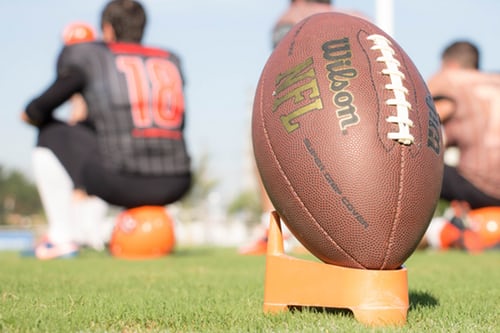Concussions and repetitive impacts to the head are frequent injuries suffered by football players. It has been reported that there is an increasing number of retired NFL players who suffered concussions during their career that have developed memory and cognitive difficulties, including dementia, Alzheimer’s Disease, depression and chronic traumatic encephalopathy (CTE).
A new device called a Q-Collar is being tested by linebacker Adam Bighill during practices and games with the Winnipeg Blue Bombers as a concussion prevention device. Bighill’s teammates are also trying out the Q-Collar, along with several members of the Saskatchewan Roughriders.
WHAT IS THE Q-COLLAR?
The Q-Collar is a metal and plastic device that forms an almost complete circle around the wearer’s neck.
Toronto colleagues, Dr. Joe Fisher and Dr. David Smith, invented the Q-Collar, which has received a Medical Device Establishment License from Health Canada authorizing the sale of the device in Canada. The device is awaiting approval in the United States.
Impact from trauma to the head can cause damage in two ways. The first is when the brain hits the skull. The second is when tissues (such as blood vessels) in the brain get stretched and torn.
HOW DOES THE Q-COLLAR WORK?
The Q-Collar exerts a slight pressure on the main blood vessels in the neck causing some blood to back up in the cranium (approximately two teaspoons). That blood fills up the extra space to protect the brain. Thus, the increased blood volume in the head acts as an airbag for the brain.
We thought that maybe if we had 10, 15 maybe even 20 per cent reduction in brain damage, it would have been a great thing but in fact it was 85-90 per cent reduction in brain damage.
According to Bighill, who had a previous concussion in high school, he was looking to prevent small impacts as well as the big hits. He stated:
It’s really about the prevention side of things. I want to be able to prevent a lot of the hits that you think might not be damaging.
The Q-Collar has endured six years of research and more than 20 laboratory and clinical studies. More than 500 individuals have participated in studies and there have been more than 500,000 impacts over 20 g-forces.
Independent clinical trials were performed with hockey, football and soccer players. Through the use of advanced magnetic resonance imaging (MRI) techniques and accelerometers to determine measurements of head impact, those athletes that were wearing the Q-Collar were found to have significantly less changes to the structure of their brain than those who were not wearing the Q-Collar.
The Q-Collar is designed for any sport or activity where an athlete is subjected to or at risk of exposure to head impacts, such as football, soccer, hockey, lacrosse, skiing, biking or auto racing. According to the research, there have been no negative impacts of wearing the Q-Collar on athletic performance.
Although the Q-Collar cannot guarantee protection against concussions, it has been found to protect the brain from head impacts. It is important to remember that using the Q-Collar should not replace the use of other protective equipment, such as helmets.
WHAT IS A CONCUSSION & WHAT ARE THE SYMPTOMS?
A concussion is a type of brain injury that occurs following an impact to the head, neck or face, or body. Unfortunately, a concussion cannot be viewed using routine image scans, such as MRI, X-ray or CT scans. Concussions can only be diagnosed by observing the changes in the way an individual thinks and feels.
The following are typical symptoms associated with concussions:
- Neck pain;
- Double vision;
- Loss of consciousness;
- Seizure or convulsion;
- Vomiting continuously;
- Severe headache;
- Weak, tingling or burning feeling in the arms or legs.
According to the report of “Traumatic Brain Injuries in Alberta”, on average there were 13,617 individuals who visited emergency departments and were diagnosed with concussions each year. The research found that the overall risk of head injuries is higher for falls (i.e. slipping, tripping or due to a collision or push by another person) than sports-related injuries.
HOW IS A CONCUSSION TREATED?
If you suspect that you have suffered a concussion, seek medical help immediately. Health professionals will monitor your symptoms and advise as to which activities you can return to. You may also require a referral to a neurologist, physiotherapy or occupational therapist.
Concussion symptoms generally last between 6 to 10 days. The following is generally recommended to treat a concussion:
- Get plenty of sleep at night and rest during the day;
- Avoid visual and sensory stimuli, including video games and loud music;
- Eat well-balanced meals;
- Slowly return to normal activities;
- Be sure to advise your employer or teacher that you have suffered a concussion;
- Avoid strenuous physical or mental tasks; and
- Avoid activities and sports that could lead to another concussion.
It is strongly recommended that you follow the advice given to you by your doctor regarding returning to activities such as driving, operating machinery, returning to sports activities or school.
If you or a loved one have suffered a head injury as the result of a sports accident or other incident, or have any questions regarding a potential claim, please contact the experienced and award winning lawyers at Cuming & Gillespie LLP today. It is important that you call us promptly so we can help you understand your rights and the potential to recover compensation for your injuries. Contact our office today online or at 403-571-0555 for a free initial consultation.

